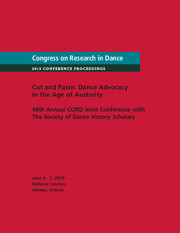Article contents
Samah—Kardeşlik Töreni: A Dynamic Bodily Archive for the Alevi Semah
Published online by Cambridge University Press: 23 September 2014
Abstract
In this paper, the current practices and discourses surrounding the Alevi semah are analysed in a peculiar reflexive and embodied manner. The semah is comprehended here as a “dynamic structured body system,” which is differently recognized as ibadet (devotional practice), dans (dance), or meditasyon (meditation), and whose practice is alleged to support ideals of inter-religious peace and gender equity. Its analysis resorts to data collected during an intensive fieldwork that was carried out between 2008 and 2011 by following the experimental theater piece with the title Samah—Kardeşlik Töreni (Samah—the Ritual of Brotherhood) of the Ankara Deneme Sahnesi amateur group based in Ankara (Turkey). This play is the result of a re-elaboration of ethnographic data that were collected throughout the Anatolian peninsula since the early 1980s by a team of students and researchers affiliated with the Theatre Department of Ankara University. In this process of re-adaptation for the stage, the semah was singled out of its religious source (the Ayin-i Cem ritual) for which it started to display a mirror image offering a condensed exposition of the Alevi rituals to an audience. This paper contextualizes these formal adaptations on the stage into the frame of the abrupt history of migration and urbanization in late twentieth century Turkey. Such historical processes played a major role in the current circulation of the semah in Turkey as well as abroad, resulting also in its perspective inscription as world intangible heritage.
- Type
- Research Article
- Information
- Copyright
- Copyright © Sinibaldo De Rosa 2014
References
Works Cited
- 1
- Cited by


